ving做定语和状语的用法
- 格式:ppt
- 大小:1.67 MB
- 文档页数:35
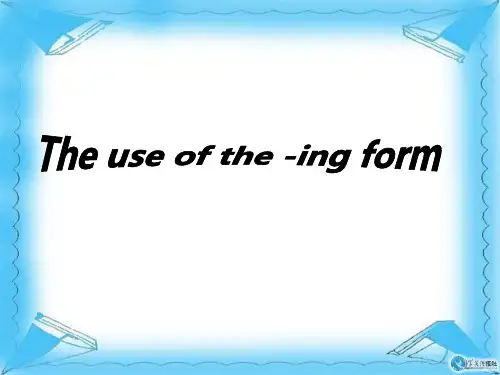
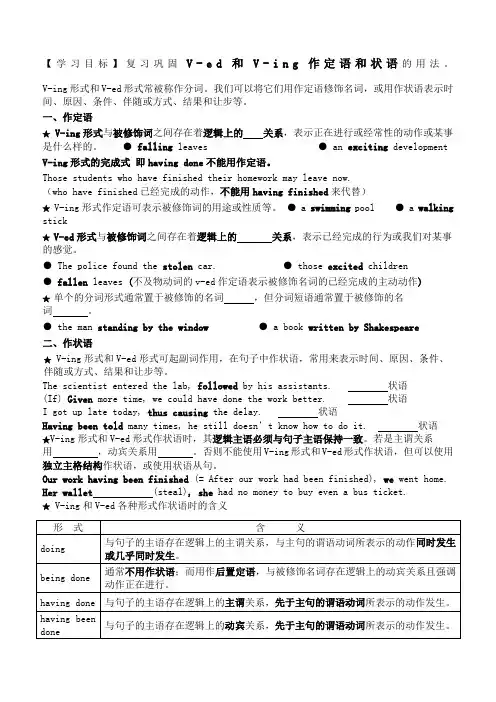
【学习目标】复习巩固V-e d和V-i n g作定语和状语的用法。
V-ing形式和V-ed形式常被称作分词。
我们可以将它们用作定语修饰名词,或用作状语表示时间、原因、条件、伴随或方式、结果和让步等。
一、作定语★ V-ing形式与被修饰词之间存在着逻辑上的关系,表示正在进行或经常性的动作或某事是什么样的。
●falling leaves ● an exciting development V-ing形式的完成式即having done不能用作定语。
Those students who have finished their homework may leave now.(who have finished已经完成的动作,不能用having finished来代替)★V-ing形式作定语可表示被修饰词的用途或性质等。
● a swimming pool ● a walking stick★ V-ed形式与被修饰词之间存在着逻辑上的关系,表示已经完成的行为或我们对某事的感觉。
● The police found the stolen car. ● those excited children●fallen leaves (不及物动词的v-ed作定语表示被修饰名词的已经完成的主动动作)★单个的分词形式通常置于被修饰的名词,但分词短语通常置于被修饰的名词。
● the man standing by the window● a book written by Shakespeare二、作状语★V-ing形式和V-ed形式可起副词作用,在句子中作状语,常用来表示时间、原因、条件、伴随或方式、结果和让步等。
The scientist entered the lab, followed by his assistants. 状语(If) Given more time, we could have done the work better. 状语I got up late today, thus causing the delay. 状语Having been told many times, he still doesn’t know how to do it. 状语★V-ing形式和V-ed形式作状语时,其逻辑主语必须与句子主语保持一致。
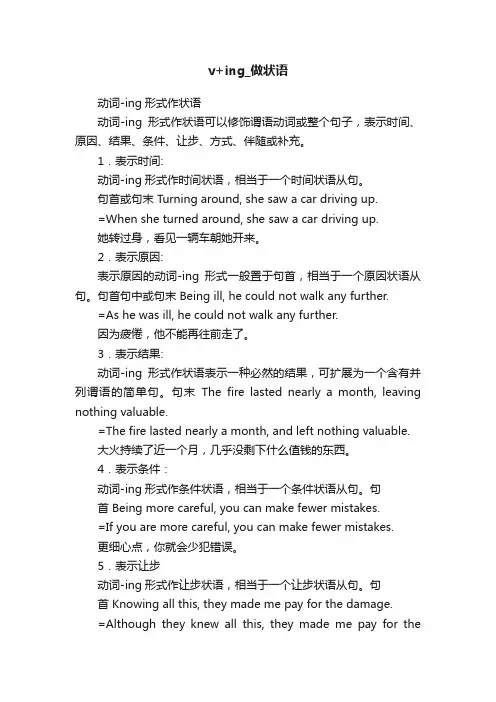
v+ing_做状语动词-ing形式作状语动词-ing形式作状语可以修饰谓语动词或整个句子,表示时间、原因、结果、条件、让步、方式、伴随或补充。
1.表示时间:动词-ing形式作时间状语,相当于一个时间状语从句。
句首或句末 Turning around, she saw a car driving up.=When she turned around, she saw a car driving up.她转过身,看见一辆车朝她开来。
2.表示原因:表示原因的动词-ing形式一般置于句首,相当于一个原因状语从句。
句首句中或句末 Being ill, he could not walk any further.=As he was ill, he could not walk any further.因为疲倦,他不能再往前走了。
3.表示结果:动词-ing形式作状语表示一种必然的结果,可扩展为一个含有并列谓语的简单句。
句末The fire lasted nearly a month, leaving nothing valuable.=The fire lasted nearly a month, and left nothing valuable.大火持续了近一个月,几乎没剩下什么值钱的东西。
4.表示条件:动词-ing形式作条件状语,相当于一个条件状语从句。
句首 Being more careful, you can make fewer mistakes.=If you are more careful, you can make fewer mistakes.更细心点,你就会少犯错误。
5.表示让步动词-ing形式作让步状语,相当于一个让步状语从句。
句首 Knowing all this, they made me pay for the damage.=Although they knew all this, they made me pay for thedamage.尽管知道了一切情况,他们还是要我赔偿损失。
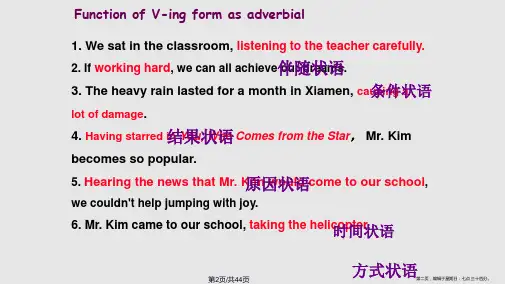
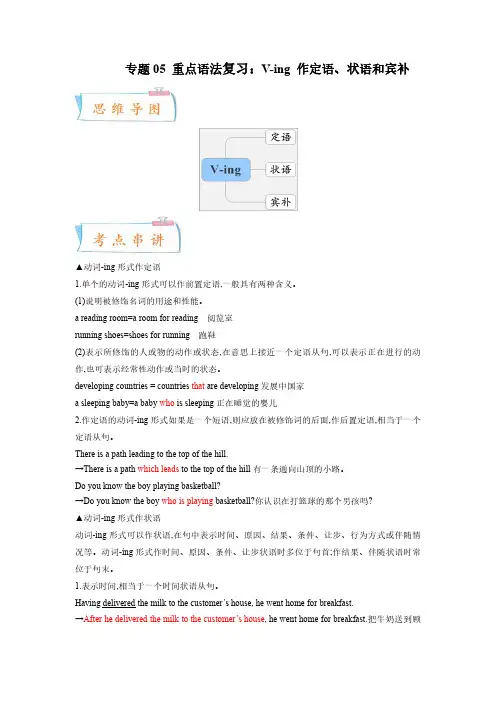
专题05重点语法复习:V-ing作定语、状语和宾补▲动词-ing形式作定语1.单个的动词-ing形式可以作前置定语,一般具有两种含义。
(1)说明被修饰名词的用途和性能。
a reading room=a room for reading阅览室running shoes=shoes for running跑鞋(2)表示所修饰的人或物的动作或状态,在意思上接近一个定语从句,可以表示正在进行的动作,也可表示经常性动作或当时的状态。
developing countries=countries that are developing发展中国家a sleeping baby=a baby who is sleeping正在睡觉的婴儿2.作定语的动词-ing形式如果是一个短语,则应放在被修饰词的后面,作后置定语,相当于一个定语从句。
There is a path leading to the top of the hill.→There is a path which leads to the top of the hill有一条通向山顶的小路。
Do you know the boy playing basketball?→Do you know the boy who is playing basketball?你认识在打篮球的那个男孩吗?▲动词-ing形式作状语动词-ing形式可以作状语,在句中表示时间、原因、结果、条件、让步、行为方式或伴随情况等。
动词-ing形式作时间、原因、条件、让步状语时多位于句首;作结果、伴随状语时常位于句末。
1.表示时间,相当于一个时间状语从句。
Having delivered the milk to the customer’s house,he went home for breakfast.→After he delivered the milk to the customer’s house,he went home for breakfast.把牛奶送到顾客家后,他就回家吃早餐了。

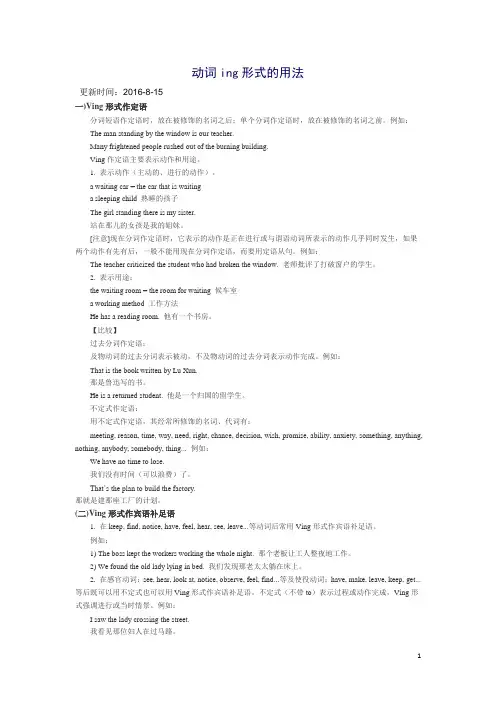
动词ing形式的用法更新时间:2016-8-15一)Ving形式作定语分词短语作定语时,放在被修饰的名词之后;单个分词作定语时,放在被修饰的名词之前。
例如:The man standing by the window is our teacher.Many frightened people rushed out of the burning building.Ving作定语主要表示动作和用途。
1. 表示动作(主动的、进行的动作)。
a waiting car = the car that is waitinga sleeping child 熟睡的孩子The girl standing there is my sister.站在那儿的女孩是我的姐妹。
[注意]现在分词作定语时,它表示的动作是正在进行或与谓语动词所表示的动作几乎同时发生,如果两个动作有先有后,一般不能用现在分词作定语,而要用定语从句。
例如:The teacher criticized the student who had broken the window. 老师批评了打破窗户的学生。
2. 表示用途:the waiting room = the room for waiting 候车室a working method 工作方法He has a reading room. 他有一个书房。
【比较】过去分词作定语:及物动词的过去分词表示被动,不及物动词的过去分词表示动作完成。
例如:That is the book written by Lu Xun.那是鲁迅写的书。
He is a returned student. 他是一个归国的留学生。
不定式作定语:用不定式作定语,其经常所修饰的名词、代词有:meeting, reason, time, way, need, right, chance, decision, wish, promise, ability, anxiety, something, anything, nothing, anybody, somebody, thing... 例如:We have no time to lose.我们没有时间(可以浪费)了。
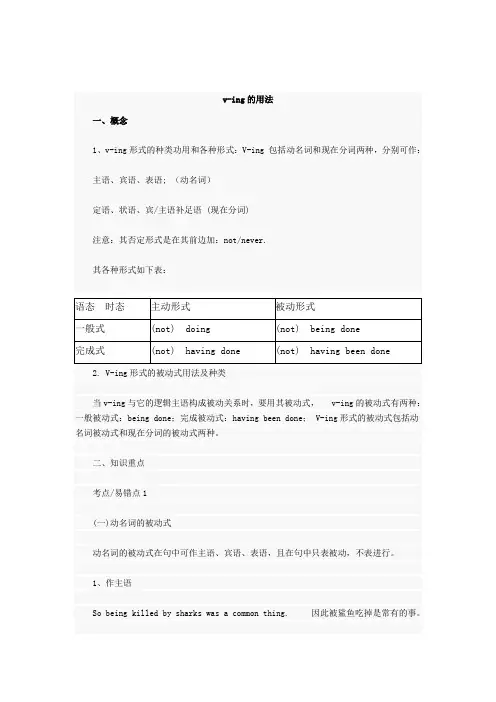
v-ing的用法一、概念1、v-ing形式的种类功用和各种形式:V-ing 包括动名词和现在分词两种,分别可作:主语、宾语、表语; (动名词)定语、状语、宾/主语补足语 (现在分词)注意:其否定形式是在其前边加:not/never.其各种形式如下表:Being laughed at in public is a terrible thing.在公共场合下被嘲笑是件可怕的事。
Being exposed to the sun does harm to health.暴漏在阳光下对身体有害。
The president's being killed led to serious consequences.总统被杀导致了严重后果。
2、作宾语V-ing形式的被动式既可作动词的宾语,也可作介词的宾语。
He was afraid of _________________ (abandon) by us.He did it without ______ _____ (ask)You can't eat anything before _____________(operate on)I remember having be en told the story.3、作表语What worried the child most was his not being allowed to visit his mother i n the hospital.使孩子最为担心的是他不被允许到医院看母亲。
What I hate most is ________________ (laugh at)The problem is for from _______________ (settle)注意:①动名词的被动式作主语和表语时,常用其一般式(being done),不习惯用完成式;但作宾语时,若其动作发生谓语动词之前或强调动作已经发生,可用其完成式(hav ing been done)。
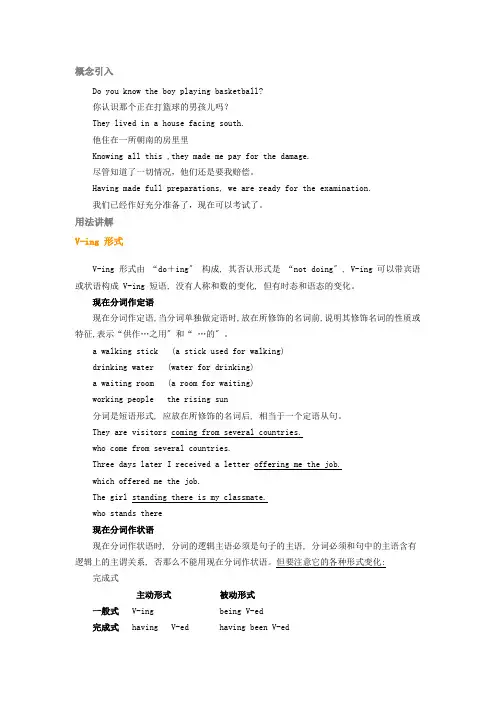
概念引入Do you know the boy playing basketball?你认识那个正在打篮球的男孩儿吗?They lived in a house facing south.他住在一所朝南的房里里Knowing all this ,they made me pay for the damage.尽管知道了一切情况,他们还是要我赔偿。
Having made full preparations, we are ready for the examination.我们已经作好充分准备了,现在可以考试了。
用法讲解V-ing 形式V-ing 形式由“do+ing〞构成, 其否认形式是“not doing〞, V-ing 可以带宾语或状语构成 V-ing 短语, 没有人称和数的变化, 但有时态和语态的变化。
现在分词作定语现在分词作定语,当分词单独做定语时,放在所修饰的名词前,说明其修饰名词的性质或特征,表示“供作…之用〞和“…的〞。
a walking stick (a stick used for walking)drinking water (water for drinking)a waiting room (a room for waiting)working people the rising sun分词是短语形式, 应放在所修饰的名词后, 相当于一个定语从句。
They are visitors coming from several countries.who come from several countries.Three days later I received a letter offering me the job.which offered me the job.The girl standing there is my classmate.who stands there现在分词作状语现在分词作状语时, 分词的逻辑主语必须是句子的主语, 分词必须和句中的主语含有逻辑上的主谓关系, 否那么不能用现在分词作状语。

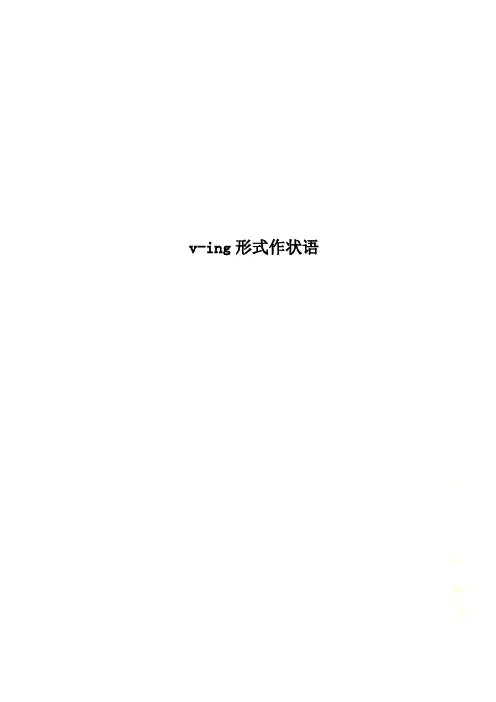
v-ing形式作状语v-ing形式作状语v-ing形式作状语时,用于修饰某动词或整个句子,所表示的动作与句子主语构成逻辑上的主谓关系。
v-ing形式作状语时,可以单独使用,也可以在其前加上when,while,after,if,unles s,although,though等连词,表示时间、原因、条件、让步、结果、伴随、方式等。
1. 作时间状语Hearing this news, she got frightened. 听到这个消息,她感到害怕。
Looking out of the window, I saw some children playing football.Turning around , he saw a tiger running up.2. 作结果状语The boy ran even faster,reaching the school out of breath. 那个男孩跑得更快了,到达学校时累得上气不接下气了。
The child slipped and fell, hitting his head against the door.Her husband died, leaving her four children.They fired, killing many people in the street.3. 作伴随状语He stood by the window, watching people passing by his window.He came running.She stood waiting for a bus.He sat there reading a book.The students ran out of the classroom, talking and laughing.4. 作原因状语Being a student, I must study hard. 作为一名学生,我必须努力学习。
v-ing 的用法1. -ing分词的构成-ing分词是由动词原形加词尾-ing构成。
-ing分词同样有时态和语态的变化,通常有下表几种形式(以do为例):一般式完成式主动形式doing having done被动形式being done having been done-ing分词的否定形式是由not 加-ing分词构成。
如:Not knowing his address, I could do nothing but stay at home and wait.不知道他的地址,我只好在家里等着。
His not coming made all of us angry. 他没来使我们大家都很生气。
2. -ing分词的一般式和完成式:-ing分词的一般式表示和谓语动词所表示的动作同时进行的动作;完成式表示在谓语动词所表示的动作之前发生的动作。
如:Being a student, he was interested in books. 作为一个学生,他对书本很感兴趣。
Not having studied his lessons very hard, he failed the examinations. 因为没有努力学习功课,他考试不及格。
3. -ing分词的被动式:-ing分词的被动式表示它的逻辑主语是-ing分词动作的承受者。
根据-ing分词动作发生的时间,-ing分词的被动式有一般被动式(being done)和完成被动式(having been done)。
如:The question being discussed is very important. 正在被讨论的问题很重要。
He never talked about his having been interviewed by the reporter. 他从来没谈起过他被记者采访的事情。
Having been criticized by the teacher, he gave up smoking.被老师批评以后,他把烟戒了。
--ving的用法:一.--ving的分类:1.动名词=动词+名词,可以在句中做主语,宾语,表语,定语。
2.现在分词=动词+形容词,可以在句中做表语,定语,宾语补助语以及状语。
主动形式被动形式一般式doing being done完成式having done having been done二.动名词做主语的用法1.抽象、笼统的动作或泛指某动作行为。
Eg.Acting out stereotypes of people from different countries can be very funny. Playing football is his hobby.Sleeping is a great pleasure.Learning a foreign language is very useful for everyone.Arguing with her is a waste of time.2. 用it代替动名词做主语的情况,结构有:It is no use/ good/ fun/ a waste of time doing sth.It’s no use going there today; he won’t be there.It’s a waste of time arguing about it. 三.动名词做宾语的用法可以置于行为动词和介词后。
Eg.I suggested having a picnic. However, we didn’t reach an agreement.I have finished checking the homework. He is good at drawing.只能用动名词做宾语的动词及短语如下Advice, avoid, allow, appreciate, enjoy, escape, finish, dislike, imagine, mind, permit, practise, suggest, can’t help, give up, insist on, feel like, spend / waste time, have difficulty/ problem/ trouble doing sth, etc.在介词后面做宾语:devote to, look forward to, be fond of, prevent from, beengaged in(忙于), depend on,be/get/become used to等Need, want, require, be worth 后接动名词主动表示被动的含义,如:The room needs cleaning. = the room needs to be cleaned.The movie is worth seeing.有的动词尽管可以用两种结构,但意义明显不同,须认真加以区别:I forgot to close the door before I left the room.I forgot having closed the door.He tried to write better. (尽量努力地写) He tried writing with a brush. (用毛笔试着写)I couldn’t help finishing it. (不能不结束某事)I couldn’t help to finish it. (不能帮助结束某事)They left off fishing. (停止钓鱼)They left off to fish. (离开某处出发去钓鱼)I regret to say that there is no wine in the bottle. (对现在要发生的事表示遗憾、抱歉)I regret not taking your advice. (后悔) 四.动名词和现在分词做定语的用法。
V-ingV-ing I-ing形式既可用作动名词也可用作现在分词,可以作主语,表语,宾语,宾语补足语,定语和状语等。
下面重点讲一下其作定语和宾语补足语的用法。
一、-ing形式作定语单个V-ing作定语时,放在被修饰词之前;V-ing短语作定语时,放在被修饰词之后,通常有以下两种意义:1. 表示动作(主动的动作),2. 表示用途。
如:The man standing by the window is our teacher.Many frightened people rushed out of the burning building.There is a swimming pool in our school.I bought a writing desk this morning.点拨:V-ing有一般式和完成式,且有主动形式和被动形式。
当句子的主语是V-ing动作的承受者时,V-ing用被动形式。
如:The building being built now will be finished next month.二、-ing形式作宾语补足语感官动词如see, hear, notice, watch, feel, smell, look at, listen to, observe及find等+ sb + doing sth,表示动作正在发生或处于一种状态中。
如:We heard the children shouting upstairs. 我们听见孩子们在楼上叫喊。
I felt my heart beating violently. 我感觉到我的心在猛烈地跳动。
I won’t have you running about in the room. 我不允许你在房间里跑来跑去。
We kept the fire burning all night long. 我们让火整夜烧着。
注意: 如果宾语补足语是一系列的动作,通常用不定式,而不用V-ing形式。